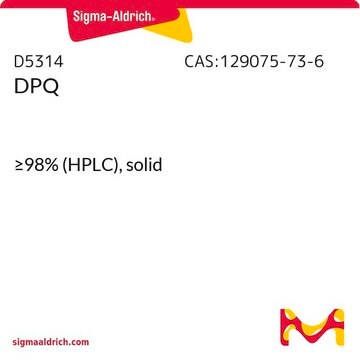H3537
HEPES solution
99.5%, liquid, BioPerformance Certified, 1 M, suitable for cell culture, 0.2 μm filtered
Synonym(s):
N-(2-Hydroxyethyl)piperazine-N′-(2-ethanesulfonic acid)
About This Item
Recommended Products
product name
HEPES solution, BioPerformance Certified, 1 M, suitable for cell culture, 0.2 μm filtered
grade
BioPerformance Certified
Quality Level
sterility
0.2 μm filtered
form
liquid
concentration
1 M
technique(s)
cell culture | mammalian: suitable
impurities
Bioburden, tested
DNase, RNase, Protease, Nickase, free
endotoxin, tested
pH
5.0-6.0
useful pH range
6.8-8.2
cation traces
Fe: <5 ppm
heavy metals (as Pb): <5 ppm
suitability
suitable for molecular biology
application(s)
diagnostic assay manufacturing
SMILES string
OCCN1CCN(CCS(=O)(O)=O)CC1
InChI
1S/C8H18N2O4S/c11-7-5-9-1-3-10(4-2-9)6-8-15(12,13)14/h11H,1-8H2,(H,12,13,14)
InChI key
JKMHFZQWWAIEOD-UHFFFAOYSA-N
Looking for similar products? Visit Product Comparison Guide
General description
Application
- To supplement Dulbecco′smodified Eagle′smedium for maintenance of cell line and RPMI medium to wash rat islets
- To recover purified ribonucleotide
- As a component of HEPES/KOH buffer and adenylation buffer for small RNA isolation and sequencing
- As a component in buffers used for nuclear extract preparation and also to supplement RPMI-1640 medium for maintenance of islets
Storage Class Code
10 - Combustible liquids
WGK
WGK 1
Flash Point(F)
Not applicable
Flash Point(C)
Not applicable
Certificates of Analysis (COA)
Search for Certificates of Analysis (COA) by entering the products Lot/Batch Number. Lot and Batch Numbers can be found on a product’s label following the words ‘Lot’ or ‘Batch’.
Already Own This Product?
Find documentation for the products that you have recently purchased in the Document Library.
Customers Also Viewed
Articles
Human pancreatic cancer organoid biobank (PDAC organoids) with various KRAS mutations to aide in 3D cell culture and cancer research applications.
Human pancreatic cancer organoid biobank (PDAC organoids) with various KRAS mutations to aide in 3D cell culture and cancer research applications.
Human pancreatic cancer organoid biobank (PDAC organoids) with various KRAS mutations to aide in 3D cell culture and cancer research applications.
Human pancreatic cancer organoid biobank (PDAC organoids) with various KRAS mutations to aide in 3D cell culture and cancer research applications.
Our team of scientists has experience in all areas of research including Life Science, Material Science, Chemical Synthesis, Chromatography, Analytical and many others.
Contact Technical Service









